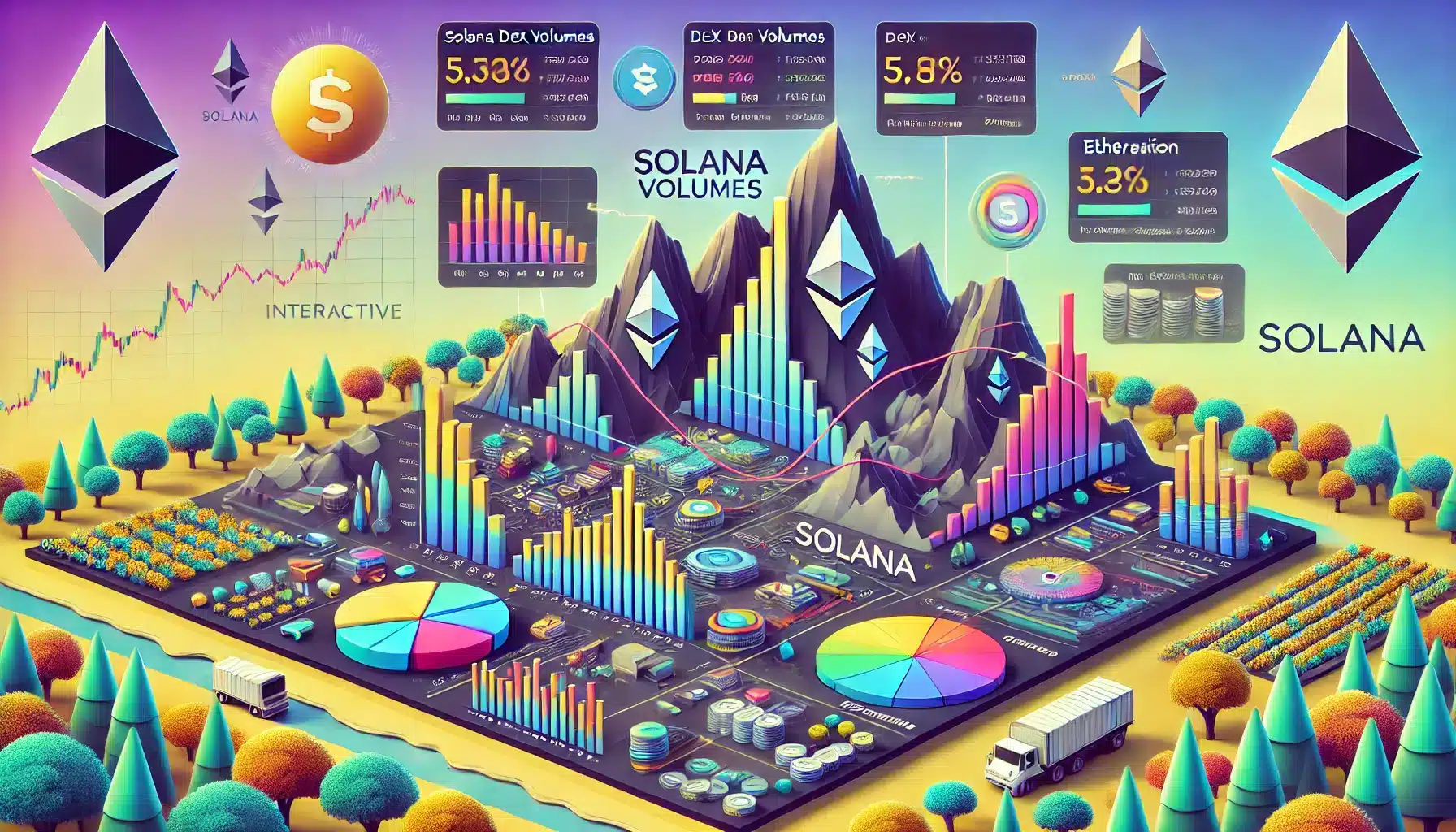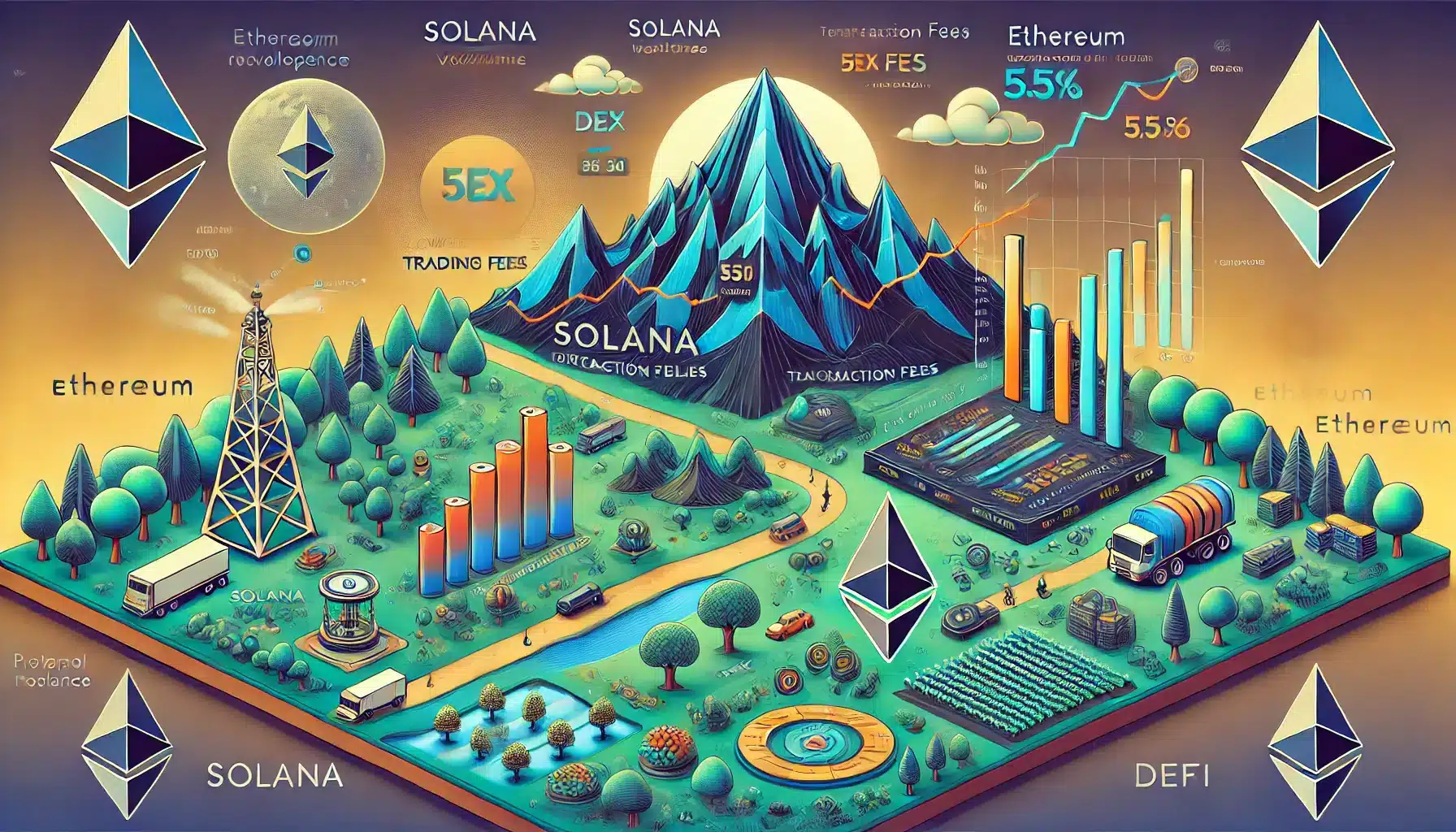 CaryptosHeadlines Media Has Launched Its Native Token CHT.
Airdrop Is Live For Everyone, Claim Instant 5000 CHT Tokens Worth Of $50 USDT.
Join the Airdrop at the official website,
CryptosHeadlinesToken.com
CaryptosHeadlines Media Has Launched Its Native Token CHT.
Airdrop Is Live For Everyone, Claim Instant 5000 CHT Tokens Worth Of $50 USDT.
Join the Airdrop at the official website,
CryptosHeadlinesToken.com
Solana’s decentralized exchange (DEX) volumes have been outperforming Ethereum in recent weeks, marking a significant shift in the DeFi landscape. With Solana’s high throughput and low transaction fees, the network has been able to sustain high trading volumes, even as the speculative memecoin market cools down.
This unexpected performance indicates a growing dominance for Solana in decentralized finance (DeFi), but will it continue to hold its ground against Ethereum? Let’s dive into the reasons behind Solana’s success and whether it can maintain this momentum.
Solana DEX Volumes Surpass Ethereum’s
Solana’s DEX volumes have been steadily rising, even surpassing Ethereum’s Layer 1 (L1) and Layer 2 (L2) networks, including Arbitrum, Optimism, and Base. Data from DeFi analytics platforms shows that decentralized exchanges like Raydium, Orca, and Jupiter on Solana are consistently processing billions of dollars in weekly trades. This rise in volumes is particularly impressive when considering that Solana’s DEXs are now rivaling Ethereum’s in terms of trade activity.
“Solana’s ability to process such high volumes without the issues of congestion seen on Ethereum’s network is a clear advantage,” explains blockchain analyst Sarah Thompson. “As Ethereum continues to struggle with high gas fees and congestion, Solana has capitalized on providing low-cost, fast transactions.”


The ongoing trend of high Solana DEX volumes represents a breakthrough for the network, particularly as it positions itself as a low-cost, high-speed alternative to Ethereum’s ecosystem.
Why Solana’s Ecosystem is Flourishing
Several factors contribute to Solana’s DEX volumes consistently outpacing those of Ethereum. First, Solana’s low fees and high throughput make it an attractive option for liquidity providers and traders. Unlike Ethereum, where gas fees can skyrocket during periods of high demand, Solana offers an efficient platform that guarantees quick and cost-effective trades.
“Solana’s ability to provide affordable and fast transactions has created an ideal environment for liquidity providers and retail traders,” says crypto expert Mark Williams. “The demand for decentralized finance (DeFi) solutions is increasing, and Solana has positioned itself as a competitor with a clear edge.”


Moreover, Solana’s ecosystem has witnessed an influx of innovative projects and applications, making it a go-to network for DeFi participants. Projects like Jupiter, which provide advanced trading features and combined liquidity, are making Solana’s ecosystem more appealing to both retail and institutional investors.
Memecoin Mania Cools, but Solana DEXs Thrive
The memecoin market, which saw speculative tokens like WIF and BONK skyrocket earlier this year, has experienced a noticeable slowdown. With sharp price corrections in memecoins, speculative trading activity across the crypto universe has declined. Despite this downturn, Solana’s DEXs have continued to thrive, signaling that the network’s growth is not solely dependent on meme-led hype.
Solana’s ability to maintain high trading volumes, even amid the cooling memecoin mania, reflects its growing usability beyond speculative assets. As Solana’s ecosystem proves resilient against market fluctuations, its adoption in more practical DeFi use cases is becoming more evident.
“Despite the decline in memecoin activity, Solana’s infrastructure is still handling high volumes, which speaks to its growing prominence in the DeFi space,” Thompson adds. “This indicates that Solana is building long-term value.”
Solana’s Growing Use Case in DeFi
One of the key reasons behind Solana’s ongoing success in decentralized exchanges is its rapidly expanding ecosystem of projects. From lending and borrowing platforms to decentralized exchanges, Solana’s infrastructure has supported a wide variety of DeFi solutions. This growth continues to attract users and developers, who are finding that Solana’s network provides a more scalable and affordable alternative to Ethereum.
In contrast, Ethereum’s network, while highly regarded, continues to face scalability issues, with high gas fees being a significant barrier to entry for smaller users. Solana’s success in this regard could mark a new phase for DeFi, where cheaper alternatives like Solana will take center stage.
Solana’s ecosystem is also continuing to evolve, with developers pushing the boundaries of innovation. The continued release of new protocols and the improvement of existing ones ensures that Solana remains competitive in the rapidly changing DeFi space.
Can Solana Sustain Its Momentum?
While Solana’s performance on DEXs has been remarkable, the question remains: can it sustain this momentum? Ethereum continues to lead the overall DeFi market, but Solana’s network provides a scalable, low-cost alternative that is increasingly attractive to both developers and users.
For Solana to continue growing, it will need to maintain its commitment to innovation and scalability. The network must ensure that it can handle increasing volumes while continuing to offer affordable transactions. Additionally, the Solana ecosystem will need to expand further, attracting even more DeFi projects and institutional participants.
With its current momentum, Solana is well-positioned to challenge Ethereum’s dominance, but much depends on the network’s ability to innovate and evolve in the coming months.
Conclusion
In conclusion, Solana has shown remarkable resilience and growth, surpassing Ethereum’s DEX volumes despite the slowdown in the memecoin market. The network’s low fees, high throughput, and innovative ecosystem make it a strong competitor to Ethereum in the DeFi space. However, Solana’s long-term success will depend on its ability to maintain high volumes, continue innovating, and expand its use cases. As the DeFi sector matures, Solana’s ecosystem is proving that it is more than just a short-term alternative – it’s here to stay. Keep following Deythere and keep an eye on crypto market trends.
FAQs
-
Why is Solana outperforming Ethereum in DEX volumes?
Solana’s low fees and high throughput make it more appealing for traders and liquidity providers compared to Ethereum’s network, which often experiences high gas fees during periods of high demand.
-
How does Solana’s network compare to Ethereum’s?
Solana offers faster and cheaper transactions compared to Ethereum, which has struggled with scalability and high gas fees, particularly on Layer 1 and Layer 2 solutions.
-
Will Solana continue to thrive in the DeFi space?
If Solana continues to innovate and expand its ecosystem, it could maintain its growth in the DeFi space, providing a scalable and affordable alternative to Ethereum.
Glossary of Key Terms
- DEX (Decentralized Exchange): A platform that allows users to trade cryptocurrencies without a central authority.
- Gas Fees: Transaction fees required to execute operations on a blockchain network.
- DeFi (Decentralized Finance): Financial services built on blockchain networks, allowing users to lend, borrow, and trade without intermediaries.












